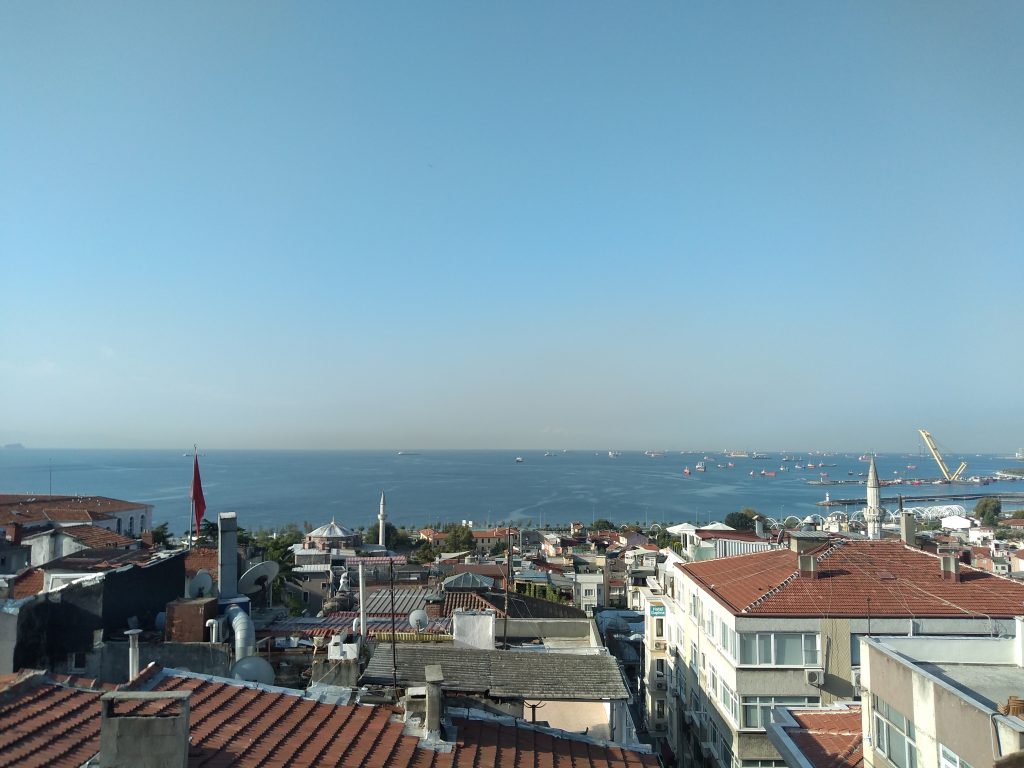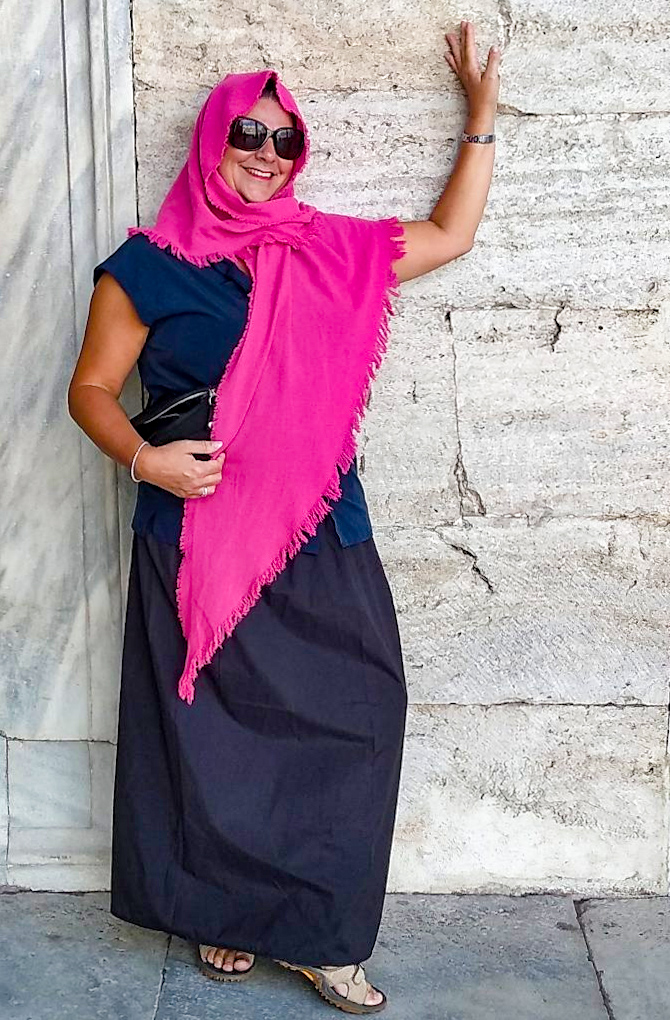“The city of the world’s desire”.

See photos
Where is Istanbul?
Within the Marmara Region north-western Turkey lies Istanbul.
Divided into districts. The main cultural, historic and tourist area is Sultanahmet (Old section).

Getting there
Having taken the bus from Plovdiv in Bulgaria to Istanbul. We arrived at the Esenler Otogari bus station in the Bayrampasa district on the European side of İstanbul.
This Istanbul terminus is the largest bus terminus in Turkey and reportedly the largest bus terminus in southeastern Europe, with 324 platforms over 4 levels, making it the third largest in the world.
There are coaches arriving and departing from almost all cities in Turkey, neighbouring countries and the rest of Europe. On average, approximately 15,000 buses per day.
Most bus companies located there have minibus shuttle services to take their passengers into other parts of the city. The company we used to get from Plovdiv in Bulgaria was the Metro bus company.
A shuttle service is offered. This meant having to wait for the next departure. Something we didn’t want to do. We just wanted to get to our accommodation as quickly as possible, having just had an 8 hour journey. We decided to take the metro into the city. A quicker and cheaper option.
Public transport in Istanbul
Istanbul’s Metro is a rapid transit railway network that serves the city. Made up of six lines, M1, M2, M3, M4, M5 and M6, with more lines under construction.
Operating from 0600 to 0000 hrs, with trains every 6–10 minutes. From August 2019, 24-hour public transport in Istanbul commenced on the metro and bus systems. Initially taking place at the weekend, Friday and Saturday nights, (between 00:30 – 05:00). Passengers being charged double the usual price. Also run on Istanbul’s religious and public holidays free of charge
If using public transport systems in Istanbul. The Istanbul Kart (travel card) is required for the ferry, metro, buses, trams and funiculars. Purchased from small kiosks near all metro and bus stations. Costing 7TL, it can be topped up with credit. Each journey costing 3.50 TL.
It is possible to purchase cards with a preset number of trips already on them, from machines directly in front of the turnstiles. The cost for these cards are 7 TL for one trip, 11 TL for two trips, 15 TL for three trips, 23 TL for five trips and 40 TL for ten trips. These machines do not accept any banknotes higher than 20 Turkish Lira, even though it says on the instructions that they do!
Getting from Esenler Otogari bus station into Istanbul
Otogar Istasyonu metro station on the M1A line is located at the bus station. Transfer into the city is simple, the metro station is well signposted, making it easy to find.
Immediately in front of the turnstiles, along with a security checkpoint are the ticket machines. Ticket machines have multiple language facilities including English.
Although it can be extremely busy, using the metro system itself is a clean and fast way to move around the city. We had to get off the metro at Aksaray station and take a tram, as we were staying in the Sultanahmet district.
From the metro station, we simply followed the signs to the T1 tramway and Yusufpasa tramway station.
Tramway’s in Istanbul are very clean and fully air-conditioned. The modern system connects most of the main attractions in the city. We constantly used it, as we found it to be cheap, fast and the easiest way to get around. The Istanbul Kart is also used for travel on the tramway system. Again ticket machines are located adjacent to the turnstiles entering the tramway station.
From Yusufpasa tramway station, we got the tram to Cemberlitas, from where it was a short walk to our hotel.
Sultanahmet District (Old section)
In the old section is the Sultanahmet district, formerly the capital of the Byzantine and Ottoman empires. We chose to base ourselves here for three nights. Perfectly situated for all of the major sightseeing spots, as most of the historic sites were all walkable from our accommodation Fehmi Bey hotel.
Our Turkish breakfast at our hotel all laid out by the rooftop terrace with views over the Bosphorus to one side and the Blue Mosque and Hagia Sophia to the other.







Light breakfast reading
Named after Sultan Ahmet I, the builder of the Blue Mosque. This district sits at one end of the leafy Sultanahmet square. Facing the Blue Mosque at the opposite end of the square is the magnificent Hagia Sophia.
Unearth the recognisable Hagia Sophia and Blue Mosque
Rising proudly some 500 metres (1,640 feet) apart in the heart of Sultanahmet. These two recognisable monuments have over a thousand years of history separating them.
Sultanahmet Meydani Square
Was within walking distance from our accommodation Fehmi Bey hotel. After settling into our hotel, we headed out to explore the surroundings. Not disappointed as we had chosen a good location. Many of the main tourist sites were close by and within walking distance. A short walk down the hill took us into the square, which is an old historic quarter where many ancient buildings can be found. Including….
Hagia Sophia
Pronounced [haˈʝia soˈfia] has a rich history, a former Greek Orthodox Christian patriarchal cathedral, later an Ottoman imperial mosque and now a museum. Built in AD 537 with an extraordinary feature; The largest Eastern Roman church in Istanbul. With it’s beautiful architecture, and religious importance. The cathedral is the oldest and fastest completed structure in the world. It’s curving dome that hangs in the air, monolithic marble columns and unique mosaics make it stand out.

In our opinion, these help to make it one of the world’s architectural marvels. Standing in the square, we were mesmerised. The combination of the buildings squareness, mixed with the huge 30m dome 55m high, this together with the colours, just took our breath away. Never-ending restoration of the Hagia Sophia is ever present, so expect to see scaffolding shrouding it.
Blue Mosque ( Sultanahmet Mosque)
The Blue Mosque built by Ajmer I is a stunning piece of architecture. Named aptly, because of its beautiful hand-painted blue tiles covering the interior walls. At night the magnificent Mosque is bathed in blue lights showing off it’s splendor. Rising up are six elegant lean minarets, five main domes and eight secondary domes making its mark on Turkey’s capital.

On entering the Blue Mosque there is a strict dress code that must be adhered to. Head covering for women these are available at the entrance for free. A scarf only needs to cover your hair. Men and women should also cover the knees, again, skirts are available at the entrance for free.


Because it is still a working mosque, it is closed to tourists during prayer time.
In general, the opening times are:-
08:30 – 11:30
13:00 – 14:30
15:30 – 16:45
Opening on Fridays at 13:30
The best way to see the grandeur of the Blue Mosque is to approach it from the West side, the Hippodrome side. If you are a non-Muslim visitor, you have to enter the Mosque from this side anyway.
Ignore and avoid the people who offer entrance to the mosque without queueing. This is just a scam in an attempt to try to sell you something or take you to their shop. The only way to enter the Mosque is to queue with the other tourists. Don’t worry, the queue moves quickly.
Tip
Make sure to visit the square at night, stand between Hagia Sophia and Blue Mosque to witness their architectural beauty enhanced by subtle lighting.
Other significant monuments in Sultanahmet Square
These include:-
Obelisk of Theodosius
Obelisk of Theodosius an Ancient Egyptian obelisk of Pharaoh Thutmose III re-erected in the Hippodrome of the square by the Roman emperor Theodosius I in the 4th century AD.
The Column of Constantine
Roman monumental column constructed in 330 AD on the orders of the Roman emperor Constantine the Great. Known also as the Burnt Stone or the Burnt Pillar.
The German Fountain
A gazebo styled fountain built in Germany, to commemorate Germans Emperor Wilhelm II’s visit to Istanbul in 1898. It was transported from Germany, then assemble piece by piece. It now sits in the northern end of Sultanahmet Square.
Other places of interest
The Basilica Cistern
Located just to the southwest of Hagia Sophia is one of Istanbul’s splendid historical buildings, the Basilica Cistern. This large underground cistern, with its marble columns rising from the water. Called the Basilica Cistern as there is a Basilica in the place where the cistern is located.
A 10 minute walk from the Basilica Cistern and we arrived at
Topkapi Palace
Construction began in 1459 by order of Sultan Mehmed the Conqueror. Topkapı means Cannon Gate, because of huge cannons displayed outside its gates. The palace complex consists of four main courtyards and many smaller buildings. Female members of the Sultan’s family lived in the harem.
Gulhane Park
Ten minutes walk from the Topkapi Palace and we got to Gulhane Park.

Adjacent to and in the grounds of Topkapı Palace, it is the oldest and one of the most expansive public parks in Istanbul.
Exiting Gulhane Park, we crossed over the main road to the waterfront, where, across the Bosphorus, we got our first sight of Asia and the famous Bogazici Bridge.

A 15 minute walk along the waterfront, adjacent to Galata Bridge, we took a 90 minute sightseeing boat trip along the Bosphorus for 20 Lira.

The boat cruises up the European side of the Bosphorus to the FSM Bridge and back down the Asian side, allowing wonderful views of this amazing city.

Disembarking the boat, we took a 15 minute walk to the
Grand Bazaar
Lose yourself in Istanbul’s biggest Grand Bazaar
Is exactly what we did.
A never-ending rabbit warren with its 4,000 plus shops. These beautiful late-Medieval domed temples house an amazing array of fake designer goods, from Chanel handbags, to Levi jeans all tightly packed in small units. Vendors vying for your attention it’s no surprise that a bargain can be purchased. Meandering further into Aladdin’s cave is the allure of colourful spices, along with traditional gold jewellery and handmade Turkish rugs. Not forgetting of course the delicious Turkish delight.

Exiting the Grand Bazaar adjacent to the Beyazit tramway station, we took the tram 1 stop to Cemberlitas, from where we walked back to our hotel.
